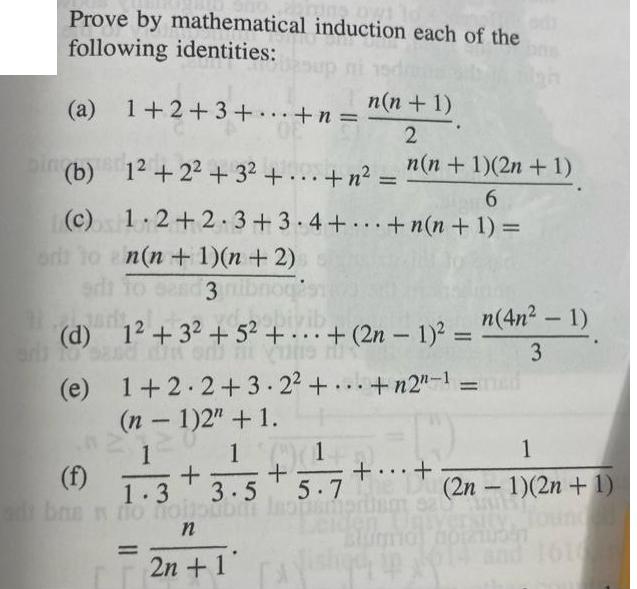Question
Prove by mathematical induction each of the following identities: 1+2+3+...+ n = (a) bin (b) (c) (d) (e) r 1 +2+3+...+n 12+2.3+3.4+...+ n(n+1) =

Prove by mathematical induction each of the following identities: 1+2+3+...+ n = (a) bin (b) (c) (d) (e) r 1 +2+3+...+n 12+2.3+3.4+...+ n(n+1) = n(n + 1)(n + 2) Bend 3 mibnog n(n+1) 2 n(n + 1)(2n +1) 6 1 +3 +5 +...+(2n-1) = n(4n - 1) 3 1+2.2+3.2+...+n2"-1 (n-1)2" + 1. 1) (1 + = (J 1 + 1.3 3.5 5.7 ad brew to bolo on Insortium sa n 2n +1' PAY Jishigay 1 (2n-1)(2n + 1) +...+ Blumniol notamusen
Step by Step Solution
3.37 Rating (153 Votes )
There are 3 Steps involved in it
Step: 1
c 12 23 nn1 nn1n2 3 n1 lhs 1 x 2 2 rhs Ihs rhs result ...
Get Instant Access to Expert-Tailored Solutions
See step-by-step solutions with expert insights and AI powered tools for academic success
Step: 2

Step: 3

Ace Your Homework with AI
Get the answers you need in no time with our AI-driven, step-by-step assistance
Get StartedRecommended Textbook for
Applied Linear Algebra
Authors: Peter J. Olver, Cheri Shakiban
1st edition
131473824, 978-0131473829
Students also viewed these Accounting questions
Question
Answered: 1 week ago
Question
Answered: 1 week ago
Question
Answered: 1 week ago
Question
Answered: 1 week ago
Question
Answered: 1 week ago
Question
Answered: 1 week ago
Question
Answered: 1 week ago
Question
Answered: 1 week ago
Question
Answered: 1 week ago
Question
Answered: 1 week ago
Question
Answered: 1 week ago
Question
Answered: 1 week ago
Question
Answered: 1 week ago
Question
Answered: 1 week ago
Question
Answered: 1 week ago
Question
Answered: 1 week ago
Question
Answered: 1 week ago
Question
Answered: 1 week ago
Question
Answered: 1 week ago
Question
Answered: 1 week ago
Question
Answered: 1 week ago
View Answer in SolutionInn App



